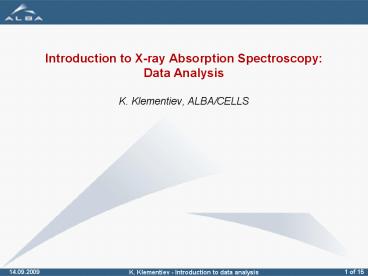1 of 15 - PowerPoint PPT Presentation
1 / 15
Title:
1 of 15
Description:
Instrumental corrections (energy calibration, deglitching etc. ... [1] S. R. Wasserman, J. Phys. IV France 7 (1997) C2-203 [2] T. Ressler, et al., Env. ... – PowerPoint PPT presentation
Number of Views:38
Avg rating:3.0/5.0
Title: 1 of 15
1
Introduction to X-ray Absorption
SpectroscopyData Analysis K. Klementiev,
ALBA/CELLS
2
Conventional EXAFS Analysis Steps
- Instrumental corrections (energy calibration,
deglitching etc.) - Subtraction of pre-edge background
- Conversion from energy dependence to wave number
dependence (E ? k) - Construction of the post-edge background ?0
- Normalization data to edge step
- kw-weighting
- Fourier transform, with optional back Fourier
transform - Determination of experimental errors in EXAFS
signal - Calculation of theoretical scattering amplitudes
and phases (ATOMS, FEFF) or extraction from
reference experimental spectra - Fitting data in k-space or r-space using
theoretical or experimental scattering
amplitudes and phases - Determination of fitting errors
- The next slides show the above steps as
screenshots of programs ATOMS, FEFF, VIPER and
XANES dactyloscope. See the corresponding
manuals.
3
Conventional EXAFS Analysis Steps
- Instrumental corrections energy calibration
derivative of absorptionspectrum of a foil
measuredsimultaneously (15 spectra are aligned
in energy)
- Instrumental corrections deglitching
4
Conventional EXAFS Analysis Steps
- Subtraction of pre-edge background
pre-edge background
- Conversion from energy dependence to wave number
dependence
Positioning of E0 at the 1st derivative maximum
of ?
5
Conventional EXAFS Analysis Steps
- Construction of the post-edge background ?0
1) through varied knots
These knots are varied in Yto achieve no FT
signal here
2) as smoothing spline
6
Conventional EXAFS Analysis Steps
- Fourier transform, with optional back Fourier
transform
7
Conventional EXAFS Analysis Steps
- Determination of experimental errors in EXAFS
signal
by FT noise at high r
by uncertainty in ?0 knots
here the error bars (noise) and ? envelope
(signal)refer to the right Y-axis
here the experimental errors are
determinedthrough high-r FT...
but be cautious with end jumps in ? function!
They contribute to FT alsoin the high-r portion.
8
Conventional EXAFS Analysis Steps
- Calculation of theoretical scattering amplitudes
and phases (ATOMS, FEFF)
Atoms by Bruce Ravel. I use WebATOMS (Google it).
There is a searchable database of input data
for ATOMS. For example, this input was generated
from the database
Visit ATOMS and FEFF web-pages for more
information!
It generates input file for FEFF6 or FEFF8(save
it as feff.inp)
9
Conventional EXAFS Analysis Steps
- Calculation of theoretical scattering amplitudes
and phases (ATOMS, FEFF)
I normally use the following way 1) create a
new folder for the new compound 2) put feff.inp
and feff.exe (temporarily) there 3) run FEFF 4)
move feff.exe to its usual location Remember to
edit feff.inp beforehand!
change the last '0' to '3' to get feffNNNN.dat
files
Remove or comment out SCF, XANES, FMS, LDOS you
do not need them for EXAFS. Put the 2nd parameter
of HOLE as less than 0.1 then S02 will be
calculated.
Ready in a second
10
Conventional EXAFS Analysis Steps
- Fitting data
An example of the simplest fitting in VIPER (see
VIPER manual and examples for more)
11
Conventional EXAFS Analysis Steps
- Determination of fitting errors
The number of independent points in the data
Degree of freedom for P varied parameters
The figure of merit
Postulated the variate ?2 obeys the
?2-distribution law with ? degrees of freedom.
This can be used to determine ?i.
In the simplest case (without a priori knowledge)
the posterior probability P(pd) ?
exp(??2/2). The 2nd central moments give the
fitting errors. See the VIPER manual/tutorial
for more explanations.
On one hand, this topic is quite broad. The
fitting errors depend on how you treat the
experimental uncertainties. They may also include
a priori knowledge. Its relative weight in
comparison to the data can be considered
differently. On the other hand, many EXAFS works
neglect the fitting errors completely. They
report some 'standard' errors, like dr 0.02 Å
and dN 10, independently of data quality,
signal strength or correlations. How deeply you
want to go into the error analysis depends on you.
12
Conventional XANES Analysis Steps
- Instrumental corrections (energy calibration,
deglitching etc.) - Subtraction of pre-edge background
- Normalization data to edge step
- Principal component analysis (PCA), target
transformation (TT) - Fitting by a linear combination of reference
spectra (if TT was successful)
XANES dactyloscope
13
Principal Component Analysis
PCA answers the question How many independent
spectra?The given here explanation of the
PCA/TT methods is not standard but I believe is
more transparent. For standard derivation based
on SVD see 1 S. R. Wasserman, J. Phys. IV
France 7 (1997) C2-203 2 T. Ressler, et al.,
Env. Sci. Technol. 34 (2000) 950
1) N spectra ? data matrix
2) make DTD (N?N matrix)?and find its
eigenvalues ?i and eigenvectors ei Always
1 ? ?iN ei??ei
3) for M linearly independent data vectors, this
sum can be truncated at iM and still 1 ?
?iM ei??ei.
4) compare D with D??iM ei??ei. If they
coincide within noise then truncate further.
Finally, M gives the number of independent
vectors.
5) alternatively, compare the cut-off part
?iM1N ei??ei with relative noise.
14
Target Transformation
1) Construct basis matrix B from N basis spectra.
Make BTB (N?N matrix)?and find its
eigenvalues ?i and eigenvectors ei
2) If the basis spectra are independent then
(BTB)-1 exists. 3) The matrix is an
orthogonal projector to the basis space (it is
equal to its square, check this). Hence, if
a spectrum S is a linear combination of the basis
spectra then B(BTB)-1BTS S and
inversely. 4) In practice one checks if
B(BTB)-1BTS coincides with S within noise.
Thus, one can answer the questions whether a
particular spectrum (material) represents a
mixture of the basis spectra (materials). When
answered positively, one can try fitting to a
linear combination of the basis spectra.
15
Conclusion
In the practical session we will follow all the
above analysis steps.































